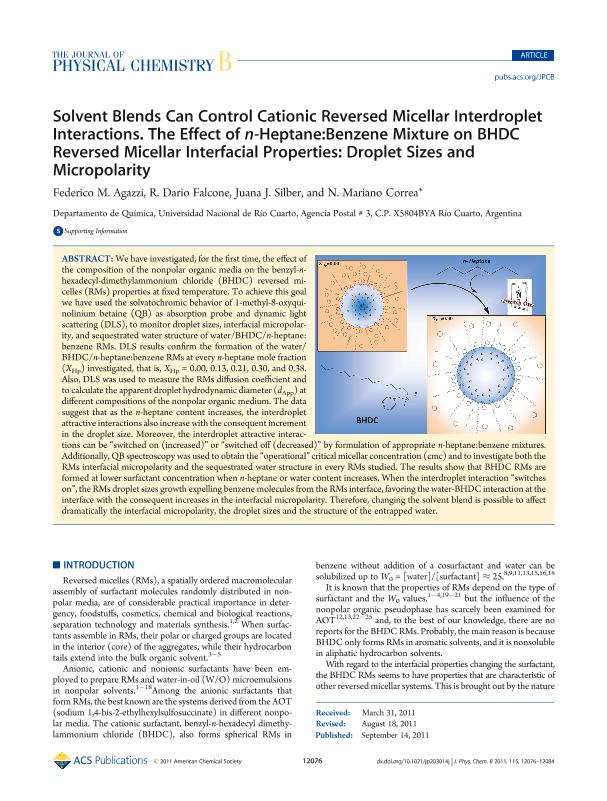Artículo
Solvent blends can control cationic reversed micellar interdroplet interactions. the effect of n- heptane:Benzene mixture on BHDC reversed micellar interfacial properties: Droplet sizes and micropolarity
Fecha de publicación:
09/2011
Editorial:
American Chemical Society
Revista:
Journal of Physical Chemistry B
ISSN:
1089-5647
Idioma:
Inglés
Tipo de recurso:
Artículo publicado
Clasificación temática:
Resumen
We have investigated, for the first time, the effect of the composition of the nonpolar organic media on the benzyl-n-hexadecyl-dimethylammonium chloride (BHDC) reversed micelles (RMs) properties at fixed temperature. To achieve this goal we have used the solvatochromic behavior of 1-methyl-8-oxyquinolinium betaine (QB) as absorption probe and dynamic light scattering (DLS), to monitor droplet sizes, interfacial micropolarity, and sequestrated water structure of water/BHDC/n-heptane:benzene RMs. DLS results confirm the formation of the water/BHDC/n-heptane:benzene RMs at every n-heptane mole fraction (X Hp) investigated, that is, XHp = 0.00, 0.13, 0.21, 0.30, and 0.38. Also, DLS was used to measure the RMs diffusion coefficient and to calculate the apparent droplet hydrodynamic diameter (dApp) at different compositions of the nonpolar organic medium. The data suggest that as the n-heptane content increases, the interdroplet attractive interactions also increase with the consequent increment in the droplet size. Moreover, the interdroplet attractive interactions can be "switched on (increased)" or "switched off (decreased)" by formulation of appropriate n-heptane:benzene mixtures. Additionally, QB spectroscopy was used to obtain the "operational" critical micellar concentration (cmc) and to investigate both the RMs interfacial micropolarity and the sequestrated water structure in every RMs studied. The results show that BHDC RMs are formed at lower surfactant concentration when n-heptane or water content increases. When the interdroplet interaction "switches on", the RMs droplet sizes growth expelling benzene molecules from the RMs interface, favoring the water-BHDC interaction at the interface with the consequent increases in the interfacial micropolarity. Therefore, changing the solvent blend is possible to affect dramatically the interfacial micropolarity, the droplet sizes and the structure of the entrapped water.
Palabras clave:
Solvent blends
,
BHDC
,
Reverse micelles
,
interfacial properties
Archivos asociados
Licencia
Identificadores
Colecciones
Articulos(CCT - CORDOBA)
Articulos de CTRO.CIENTIFICO TECNOL.CONICET - CORDOBA
Articulos de CTRO.CIENTIFICO TECNOL.CONICET - CORDOBA
Citación
Agazzi, Federico Martin; Falcone, Ruben Dario; Silber, Juana J.; Correa, Nestor Mariano; Solvent blends can control cationic reversed micellar interdroplet interactions. the effect of n- heptane:Benzene mixture on BHDC reversed micellar interfacial properties: Droplet sizes and micropolarity; American Chemical Society; Journal of Physical Chemistry B; 115; 42; 9-2011; 12076-12084
Compartir
Altmétricas




